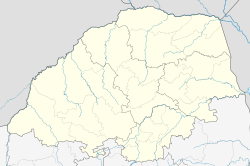Mabulane
Penge | |
|---|---|
| Coordinates: 24°22′59″S 30°19′01″E / 24.383°S 30.317°E | |
| Country | South Africa |
| Province | Limpopo |
| District | Greater Sekhukhune |
| Municipality | Fetakgomo Tubatse |
| Area | |
• Total | 28.54 km2 (11.02 sq mi) |
| Population (2011)[1] | |
• Total | 2,819 |
| • Density | 99/km2 (260/sq mi) |
| Racial makeup (2011) | |
| • Black African | 99.4% |
| • Coloured | 0.2% |
| • Indian/Asian | 0.1% |
| • White | 0.3% |
| • Other | 0.1% |
| First languages (2011) | |
| • Northern Sotho | 94.8% |
| • Zulu | 1.3% |
| • English | 1.1% |
| • Other | 2.9% |
| Time zone | UTC+2 (SAST) |
| Postal code (street) | 1160 |
Penge, alternatively known as Mabulane, is a township in Sekhukhune District Municipality in the Limpopo province of South Africa.
Mining village on the Lepelle River, 37 km north of Burgersfort. It was established after amosite was discovered there in 1907. Named after Kgosi Mabulane of Roka Motshana tribal authority or alternatively Penge, a suburb of London.[2]
- ^ a b c d "Main Place Mabulane". Census 2011.
- ^ "Dictionary of Southern African Place Names (Public Domain)". Human Science Research Council. p. 363.

